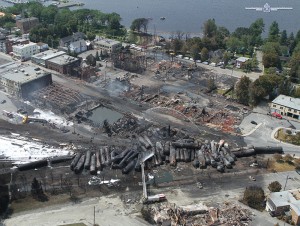 Railroad & safety advocates weigh in on LNG rule for tank car trains
Railroad & safety advocates weigh in on LNG rule for tank car trains
Article by Julie Sneider, Senior Associate Editor, Progressive Railroading, February 2020
The Pipeline and Hazardous Materials Safety Administration’s (PHSMA) proposed rule that would allow liquefied natural gas (LNG) to be transported by rail attracted comments last month from the rail industry in support of the rule, and safety advocates who oppose it.
The comment period on PHSMA’s proposed rulemaking closed Jan. 13. National Transportation Safety Board (NTSB) members, attorneys general from 16 states and at least two U.S. senators expressed concerns about what they say would be a risk to public safety should trains be allowed to move LNG in tank cars.
Association of American Railroads (AAR) and American Short Line and Regional Railroad Association (ASLRRA) officials say transporting LNG in tank cars would improve transportation safety, given the rail industry’s strong safety record on a ton-mile basis for transporting hazardous materials.
In coordination with the Federal Railroad Administration (FRA), PHMSA published the proposed rule in October 2019 to allow LNG to be transported by DOT-113C120W specification tank cars. The rule was drafted in response to President Donald Trump’s executive order that the U.S. Department of Transportation (USDOT) fast-track a process to allow LNG to be moved by rail.
Currently, LNG can be transported by rail only with a PHMSA special permit or by portable tank with FRA approval. USDOT officials have asserted the proposed rule prioritizes safety while supporting economic benefits of additional transportation options for American energy resources.
Association of American Railroads says that LNG by rail is safe
In their comments, AAR and ASLRRA noted that LNG can be transported by truck, but there’s a safety benefit in allowing LNG to be transported by rail. For example, they noted railroads account for about 3 percent of the hazardous materials incidents that trucks are involved in, despite roughly equal hazmat ton-mileage.
The rail industry also encouraged PHMSA to consider allowing LNG to be transported by the 113C140 tank car in addition to the 113C120 tank car, and to refrain from including a limit on train length.
But in their letter to PHMSA, NTSB officials raised concerns that public safety would be at risk if the agency advances the LNG rule without further study. The board suggested the rule should at least include additional route planning requirements; limit the speed of trains moving large blocks of LNG tank cars; and require LNG trains to be equipped with electronically controlled pneumatic brakes.
Senators, AGs raise concerns about LNG trains
Also expressing concerns were U.S. Sens. Ron Wyden and Jeff Merkley (D-Ore.). In a letter to PHMSA Administrator Howard Elliott, the senators wrote that loosening restrictions on transporting LNG by rail “would pose serious threats to public safety that do not appear to have been adequately considered” by the rulemaking.
The letter mentioned multiple accidents involving trains carrying hazardous materials, including a 2016 derailment in Mosier, Oregon, that spilled 42,000 gallons of crude oil into the Columbia River Gorge and sparked a large fire.
Meanwhile, attorneys general from California, Maryland, New York and 13 other states filed their opposition to the LNG rule, claiming it ignores safety risks and doesn’t substantially address environmental issues. They urged the rule’s withdrawal until further study and an environmental impact statement are completed.
###########################
THE EXPLOSION RISK of transporting volatile liquefied natural gas in vulnerable tank cars through major population centers is off the charts.
Yet the Trump administration is proposing a rule that would allow trains to travel the country filled with an unprecedented amount of explosive liquefied natural gas. The National Transportation Safety Board and the National Association of State Fire Marshals are objecting to the proposed rule.
Here’s what you should know:
What You Should Know About Liquefied Natural Gas and Rail Tanker Cars | Earthjustice, January 13, 2020


{ 1 comment… read it below or add one }
A VERY GOOD ASSESSMENT OF POTENTIAL LONG-TERM DAMAGE TO OUR FEDERAL RULE-MAKING AND JUDICIAL SYSTEMS!
I did not read the 98-pages of affidavits, but in the other text saw no mention of RR track conditions and control systems that have figured prominently in derailments and require reduced speeds on many sections of track. The condition of the physical systems must be considered and inspected frequently owing to weather and other hazards, collisions at RR-highway crossings as an unpredictable but anticipated, perhaps all too frequent, occurrence.
Unfortunately, we have no fool-proof material transportation modes. And our risk management and insurance rates are woefully at the mercy of political decision-makers with woeful levels of confidence in scientific and technical analysis and weight of evidence.